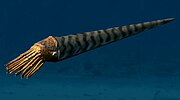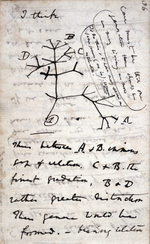the Cambrian, cephalopods are most common in shallow near-shore environments, but they have been found in deeper waters too. Cephalopods were thought to...
37 KB (4,187 words) - 18:48, 9 November 2024
species of cephalopods have been identified. Two important extinct taxa are the Ammonoidea (ammonites) and Belemnoidea (belemnites). Extant cephalopods range...
139 KB (15,486 words) - 14:22, 6 November 2024
is truly convergent evolution or parallel evolution. Unlike the vertebrate camera eye, the cephalopods' form as invaginations of the body surface (rather...
11 KB (1,262 words) - 07:21, 23 August 2024
difficult to measure in nonhuman animals, cephalopods are the most intelligent invertebrates. The study of cephalopod intelligence also has an important comparative...
32 KB (3,172 words) - 09:19, 17 September 2024
Coleoidea (redirect from Soft-bodied cephalopods)
(August 2011). "Cephalopod origin and evolution: A congruent picture emerging from fossils, development and molecules: Extant cephalopods are younger than...
9 KB (865 words) - 12:33, 14 October 2024
Goniatite (category Prehistoric cephalopod orders)
Goniatids, informally goniatites, are ammonoid cephalopods that form the order Goniatitida, derived from the more primitive Agoniatitida during the Middle...
7 KB (793 words) - 15:25, 21 June 2024
Ammonitida (category Cephalopod orders)
Ammonitida or "True ammonites" are an order of ammonoid cephalopods that lived from the Jurassic through Paleocene time periods, commonly with intricate...
2 KB (204 words) - 19:33, 18 November 2024
Orthoceratidae (category Prehistoric cephalopod families)
Orthoceratidae is an extinct family of actively mobile carnivorous cephalopods, subclass Nautiloidea, that lived in what would be North America, Europe...
3 KB (278 words) - 20:09, 18 November 2024
Plectronoceras (category Cambrian molluscs of North America)
of cephalopod evolution", in Wilbur, Karl M.; Clarke, M.R.; Trueman, E.R. (eds.), The Mollusca, vol. 12. Paleontology and neontology of Cephalopods,...
3 KB (213 words) - 08:33, 18 November 2024
Endocerida (category Ordovician cephalopods)
a group of cephalopods from the Lower Paleozoic with cone-like deposits in their siphuncle. Endocerida was a diverse group of cephalopods that lived...
13 KB (1,355 words) - 12:35, 14 October 2024
Orthoceras (redirect from Orthoceras (cephalopod))
Orthoceras is a genus of extinct nautiloid cephalopod restricted to Middle Ordovician-aged marine limestones of the Baltic States and Sweden. This genus...
5 KB (437 words) - 01:31, 30 October 2024
Belosepiellidae is an extinct family of cephalopods, including just two species. "World Register of Marine Species". 1454583. Retrieved July 3, 2024. v...
581 bytes (24 words) - 11:53, 4 July 2024
Otto Schindewolf (section Evolution)
the evolution of corals and cephalopods. Schindewolf was on the faculty at the University of Marburg from 1919 until 1927. Then he became director of the...
7 KB (709 words) - 14:23, 10 September 2023
Orthocerida (category Mesozoic cephalopods)
Orthocerida, also known as the Michelinocerida, is an order of extinct orthoceratoid cephalopods that lived from the Early Ordovician (490 million years ago)...
10 KB (1,019 words) - 11:12, 24 December 2023
Evolution is the change in the heritable characteristics of biological populations over successive generations. It occurs when evolutionary processes...
240 KB (24,900 words) - 03:29, 23 November 2024
Nautiloid (category Paleozoic cephalopods)
Nautiloids are a group of marine cephalopods (Mollusca) which originated in the Late Cambrian and are represented today by the living Nautilus and Allonautilus...
37 KB (3,465 words) - 01:30, 15 November 2024
Nautilida (category Paleozoic cephalopods)
The Nautilida constitute a large and diverse order of generally coiled nautiloid cephalopods that began in the mid Paleozoic and continues to the present...
10 KB (1,127 words) - 20:30, 18 November 2024
Permoteuthis (category Prehistoric cephalopod genera)
genus of belemnite, an extinct group of cephalopods. Paleontology portal Belemnite List of belemnites Sepkoski, Jack (2002). "A compendium of fossil...
872 bytes (42 words) - 12:26, 27 August 2024
Octopus (category CS1 maint: DOI inactive as of November 2024)
coleoid cephalopods but unlike more basal cephalopods or other molluscs, are capable of greater RNA editing, changing the nucleic acid sequence of the primary...
116 KB (12,080 words) - 20:07, 21 November 2024
Ammonoidea (category Cephalopods described in 1884)
Ammonoids are extinct spiral shelled cephalopods comprising the subclass Ammonoidea. They are more closely related to living coleoids (i.e., octopuses...
52 KB (5,802 words) - 23:24, 29 October 2024
Ceratitida is an order that contains almost all ammonoid cephalopod genera from the Triassic as well as ancestral forms from the Upper Permian, the exception...
2 KB (184 words) - 19:42, 18 November 2024
internal bodypart found in many cephalopods of the superorder Decapodiformes (particularly squids) and in a single extant member of the Octopodiformes, the vampire...
7 KB (430 words) - 15:42, 4 June 2024
Ellesmerocerida (category Cephalopod orders)
The Ellesmerocerida is an order of primitive cephalopods belonging to the subclass Nautiloidea with a widespread distribution that lived during the Late...
8 KB (890 words) - 19:49, 18 November 2024
Plectronocerida (category Prehistoric cephalopod orders)
shelled cephalopods, plectronocerids had a tube called a siphuncle, which let them fill the chambers of their phragmocone with gas instead of water, thus...
4 KB (424 words) - 09:36, 14 February 2023
diversification of brachiopods through geologic time Evolution of cephalopods – Origin and diversification of cephalopods through geologic time Evolution of fish –...
26 KB (4,569 words) - 21:37, 9 October 2024
The evolution of cetaceans is thought to have begun in the Indian subcontinent from even-toed ungulates (Artiodactyla) 50 million years ago (mya) and to...
83 KB (9,845 words) - 22:20, 15 November 2024
Teuthology (category Cephalopod stubs)
is the study of cephalopods. Cephalopods are members of the class Cephalopoda in the Phylum Mollusca. Some common examples of cephalopods are octopus,...
6 KB (495 words) - 16:02, 17 August 2024
Bactritida (category Paleozoic cephalopods of Europe)
Bactritida are a small order of more or less straight-shelled (orthoconic) cephalopods that first appeared during the Emsian stage of the Devonian period (407...
7 KB (713 words) - 06:26, 18 November 2024
Belemnoidea (category Mesozoic cephalopods)
Cretaceous. Other fossil cephalopods include baculites, nautiloids and goniatites. Belemnoids possessed a central rostrom/guard made of aragonite and with negative...
12 KB (1,252 words) - 09:58, 4 February 2024
Orthocone (category Cephalopod zootomy)
curved. An orthoconic form evolved several times among cephalopods, and, among nautiloid cephalopods, is prevalent among the ellesmerocerids, endocerids...
4 KB (414 words) - 10:21, 22 April 2024





















